Len Deighton is an English author known for his novels, works of military history, screenplays and cookery writing. He had a varied career, including as a pastry cook, waiter, co-editor of a magazine, teacher and air steward before writing his first novel in 1962: The IPCRESS File. He continued to produce what his biographer John Reilly considers "stylish, witty, well-crafted novels" in spy fiction, including three trilogies and a prequel featuring Bernard Samson.
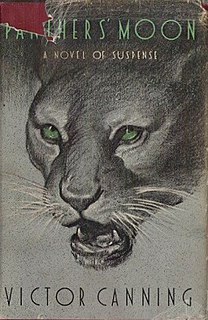
Panther's Moon is a 1948 spy thriller novel by the British writer Victor Canning. It was his second post-war novel, following The Chasm, as he had largely been taken a break from writing during his wartime service.

Mysterious Mr. Sabin is a 1898 spy thriller novel by the British writer E. Phillips Oppenheim. It was the first spy novel by Oppenheim, a genre which he came to dominate during the First World War and interwar era. Revolving around a plot of a Frenchman selling British military secrets it became a bestseller, establishing him as a popular writer. It has been described as the novel "that launched Oppenheim's career of xenophobic espionage fantasy". It contains elements of invasion fiction, a common genre theme at the time.

Time Right Deadly is a 1956 thriller novel by the British writer Sarah Gainham. Her debut novel, it was shortlisted for the Gold Dagger Award, losing out to Edward Grierson's The Second Man. Like many of her novels it takes place in post-war Austria, where she lived.
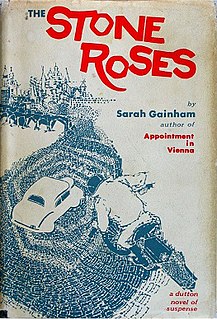
The Stone Roses is a 1959 spy thriller novel by the British writer Sarah Gainham. It is set in Prague shortly after the Communist coup in Czechoslovakia.

The Cold Dark Night is a 1957 spy thriller novel by the British writer Sarah Gainham. Her second novel, it is set at the height of the Cold War when the 1954 Berlin Conference saw the Big Four foreign ministers arrive in the divided city. Gainham had worked in Berlin as a journalist at the time of the Conference.
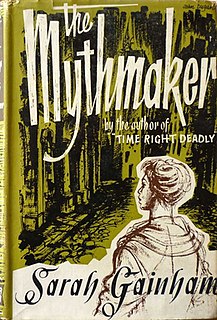
The Mythmaker is a 1957 spy thriller novel by the British writer Sarah Gainham, her third published novel. At with many of her works it takes place in Vienna, where she settled in the post-war era. It was released in the United States in 1958 under the alternative title Appointment in Vienna.

The Silent Hostage is a 1960 spy thriller novel by the British writer Sarah Gainham. Before writing her most celebrated work Night Falls on the City, Gainham produced several thrillers set in Continental Europe where she had lived since 1947. The novel takes place on the Adriatic Coast of Yugoslavia not long after the Second World War.

The Mystery of the Open Window is a 1929 mystery detective novel by Anthony Gilbert, the pen name of British writer Lucy Beatrice Malleson. It is the fourth novel in a series featuring her amateur detective, the politician Scott Egerton. Unlike the rest of the series it was published by Gollancz rather than Collins. It takes the form of a locked room mystery, a popular branch of the genre during the Golden Age of Detective Fiction.
Lynn Brock (1877-1943) was the pseudonym of the Irish writer Alister McAllister, who moved to England and wrote a series of mystery novels. Brock is best known for his series of Colonel Gore detective novels, which enjoyed popularity in the 1920s and 1930s during the Golden Age of Detective Fiction. His novels employ a complexity of style and are generally set in rural locations. He also wrote several plays under the name Anthony Wharton.

A Forest of Eyes is a 1950 spy thriller novel by the British writer Victor Canning. Stylistically it owed a debt to Canning's friend, the writer Eric Ambler.

The Chasm is a 1947 thriller novel by the British writer Victor Canning. It was his first novel since the Second World War during which he had served in the Royal Artillery and was largely absent from the writing world. Later he increasingly turned to espionage and crime novels. It takes place in Italy where Canning had served during the Italian campaign.

Queen's Pawn is a 1969 thriller novel by the British writer Victor Canning. The title is a reference to the chess opening of the same name and the fact that much of the novel's action centres around the Queen Elizabeth 2 ocean liner. It was his first novel after finishing the Rex Carver series of spy adventures.

The Whip Hand is a 1965 spy novel by the British writer Victor Canning. It is the first in a series of four novels about Rex Carver, a private detective drawn back into his old profession of espionage. The novel also features the secret service agent Manston who had previously appeared in The Limbo Line, Canning's previous novel.

The Python Project is a 1967 spy thriller novel by the British Victor Canning. It is the third in a series of four novels about Rex Carver, a private detective drawn back into his old profession of espionage. A complex plot which involves a jewel robbery and the exchange of prisoners between the British and Soviet intelligence services takes place in a variety of locations including London, Paris, Libya and the Balearic Islands.

The Melting Man is a 1968 thriller novel by the British Victor Canning. It is the fourth and final entry in a series novels about Rex Carver, a private detective drawn back into his old profession of espionage. It features the French secret agent Aristide de la Dole, who had previously appeared in Doubled in Diamonds.

Firecrest is a 1971 spy thriller novel by the British writer Victor Canning. A stand-alone novel, it introduced a more modern, darker and naturalistic style compared to Canning's previous novels. It marked the first appearance of "The Department", a shadowy dirty tricks agency working for the British government which featured in subsequent novels.

Inspector French's Greatest Case is a 1924 mystery detective novel by Freeman Wills Crofts. It in his series of novels featuring Inspector French, a Scotland Yard detective of the Golden Age known for his methodical technique. Like much of the following series the plot mixes the traditional form of the puzzle mystery with that of a police procedural. French has to carefully study railway and shipping timetables and crack a cipher in order to solve his case.
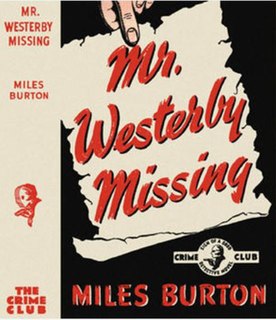
Mr. Westerby Missing is a 1940 detective novel by the British writer Cecil Street, writing under the pen name of Miles Burton. It was the twenty-second in a series of books featuring the detective Desmond Merrion and Inspector Arnold of Scotland Yard. It was published in the United States by Doubleday the same year.
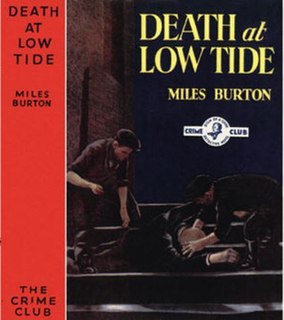
Death at Low Tide is a 1938 detective novel by the British writer Cecil Street, writing under the pen name of Miles Burton. It is the seventeenth in a series of books featuring the Golden Age amateur detective Desmond Merrion and Inspector Arnold of Scotland Yard. A review in the Times Literary Supplement declared "this is probably the best work of an author who has already had many brilliant successes". However The Observer noted "Miles Burton still remains faithful to the Crofts school in his austere refusal to develop a style."


















